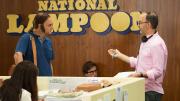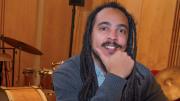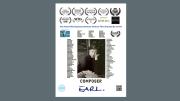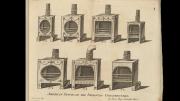Doug Kenney ’68 used to go around Hollywood claiming he’d created nostalgia—or at least co-created it, and at least for a certain stripe of American male. Alongside fellow Harvard men Henry Beard ’67 and Rob Hoffmann ’67, M.B.A. ’72, Kenney made a career out of his college extracurricular by taking the Harvard Lampoon national. Beyond its parodies of other publications, the magazine spun off a live musical and a radio show, as well the movies Animal House and Caddyshack. It collected a wellspring of talent for more enduring ventures like Saturday Night Live. It was a forerunner to outfits like Funny or Die and CollegeHumor. In setting this in motion, and then dying mysteriously and young, Kenney became a comedy legend: the kid genius who made fun into a franchise, and never had to grow up.
Would Kenney have enjoyed what he inspired? If worry is the destroyer of happiness, nostalgia is the destroyer of dignity. Nostalgia dragged the National Lampoon through a long, sad senescence, until its final issue in 1998. Nostalgia gave a jolt of resources to the brand’s recent zombie spasm: the 2015 remake of Vacation, in which Ed Helms takes Chevy Chase’s seat.
The new biopic A Futile and Stupid Gesture, co-written by John Aboud ’95 and Michael Colton ’97 (and based on the Josh Karp book of the same name), wants to avoid going misty-eyed about its subject. It brings Kenney back from the dead, imagining him in old age, with a trim white beard—and then it lets him narrate the movie. “Modern Doug” scoffs at storytelling shortcuts (“You really want to start there?...there’s gotta be a better way to start a movie!”), and defends others (“Come on, do you really think I looked like Will Forte when I was 27? You think Forte is 27?”). "I guess we were trying to have our cake and eat it too,” Colton says freely.
The writers don’t take the liberty of speculating about what Kenney might’ve gotten up with 40 more years on this earth: Modern Doug is more convenience than character. But it does imagine him snorting at praise: “That’s blowing smoke up my own ass.” And yet it’s true, according to the screenwriters. In a recent interview, they sketched a quick lineage of American humor that placed National Lampoon as the prime progenitor. In the 1950s, comedy was generally tamer, says Colton. It was Jack Benny on the radio and Bob Hope specials on TV. Kenney’s cohort spearheaded what was then called “sick humor” bringing it into the mainstream.
“Today we're going through quite a bit in society and culture about the role of comedy,” says Aboud. “Comedy as resistance.” That, too, he traces back to the National Lampoon. “When Nixon was in the White House, the magazine went after him relentlessly. And now we're seeing Samantha Bee, today, going after our current president. So that tradition is alive and well.”
But what was considered radical once can look retrograde now. “So much of the material back then is either sexist or racist or just plain weird,” acknowledges Aboud. So “Modern Doug” also comments on Lampoon antics that’d be objectionable today, ventriloquizing contemporary sensibilities. At one point, a young black couple walks past the publication’s offices and questions why the staff had no black writers and only one woman. “I’m sure they were out there, we just didn’t think to look. You know, it was a different time,” he responds. “In our defense, we also had very few Jews.”
In Colton’s account of such scenes, “From a 2018 perspective, when diversity is taken much more seriously than it was in the ’70s—you know, Modern Doug allows us to poke at that, and comment on it.”
“In an interesting way,” adds Aboud.
“That was important to us,” continues Colton. “That it feel like a movie of today and not just a period piece.”
“And all while being true to the warts-and-all nature of that group,” says Aboud.
Even as A Futile and Stupid Gesture tries to gain distance from some of that generation’s political sensibilities, it’s wistful for the National Lampoon’s golden era. Theirs was a more innocent time, in being fundamentally juvenile—the humor rude, sex-crazed, irresponsible, unselfconscious. Early in the biopic, a young Kenney declares, “Comedy doesn’t have to be pretty. It should be raw. Fuckin’ rock and roll!” He arguing with Beard over the magazine’s art direction—and loses—but on a deeper level, the movie’s sympathies lie with him. At bottom, it’s a fanboy tribute: light and loving, a chance for recognizably famous actors to cosplay their heroes.
And for all its arch meta-narrative devices, the movie tells a simple story—or several. One is a kind of romantic tragedy, tracking how Beard and Kenney’s creative partnership dissolved. Another is a family drama, and about how comedic gifts stem from primal pain: Kenney, the spare son, could never compensate for his elder brother’s untimely death, and so his story starts with the funeral. The third is about how outsiders become insiders (insofar as anyone who hangs out in a castle and throws lobster during food fights can be called anti-establishment).
It hardly needs saying that the screenwriters have strong personal ties to their subject matter. They first met through the Harvard Lampoon, where Aboud supervised Colton’s freshman tryout. “I didn't get on,” says Colton. “And now I joke that it's like a Twilight Zone episode, where he's forced to work with me every day for the rest of his life because he wouldn't let me on the Lampoon.” After college, they went in together on a new venture, Modern Humor, which they pitched to investors as a Lampoon for the digital age. Like their print forbears, they got their first flush of attention by spoofing a prominent publication, Tina Brown’s Talk, just as Beard and Kenney had done with Playboy. Otherwise, Colton and Aboud’s partnership doesn’t really parallel the earlier one: “I'm probably more Doug because I have a vape pen,” offers Colton; otherwise, they’re “even-keeled.” Another key difference: “We went out of business very quickly,” says Colton. With the dot-com bubble deflating, they funded the site by selling ideas to Comedy Central and New Line Cinema, and thus segued into screenwriting.
Whatever else, Kenney and company left a deep Harvard legacy. Though Aboud insists “‘professional’ and ‘Lampoon’ do not belong in the same sentence,” the trio blazed a trail for Harvard students who wanted to become entertainers. The number of Lampoon alumni pursuing comedy has grown ever since, according to Colton: “For better or for worse!”








